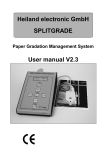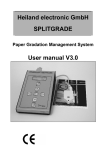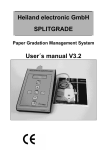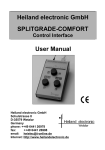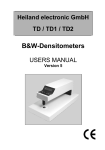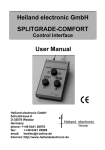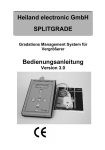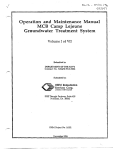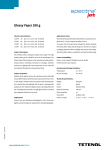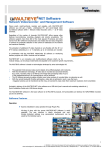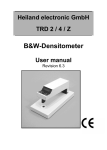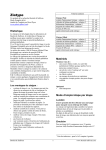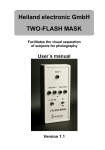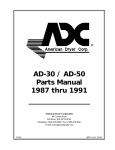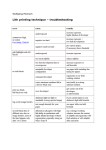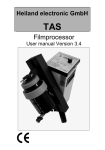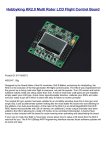Download the version 2.2 User`s Manual in format. Use it for
Transcript
Heiland electronic GmbH SPLITGRADE Paper Gradation Management System User manual V2.2 Contents SCHEMATIC VIEW OF THE COMPLETE SPLITGRADE SYSTEM ............ 4 THE PRODUCT .......................................................................................... 5 COPYRIGHT............................................................................................... 5 W ARRANTY ............................................................................................... 5 TECHNICAL SPECIFICATIONS OF THE CONTROL UNIT ...................................... 6 FACTORY CALIBRATED PAPER TYPES............................................................ 7 FACTORY CALIBRATED FILM TYPES ............................................................... 8 CONTENTS OF THE DELIVERY ...................................................................... 8 FEATURES ................................................................................................ 9 OPERATION CONDITIONS...................................................................... 10 SAFETY ADVICE ....................................................................................... 10 INSTALLING THE FILTER MODULE AND CONTROLLER...................... 10 CONNECTING THE SYSTEM ........................................................................ 11 USING THE CONTROLLER ..................................................................... 12 DESCRIPTION OF THE PUSH-BUTTONS AND THE DISPLAY ............................... 12 DISPLAY ................................................................................................. 12 THE PATH TO HIGH QUALITY PRINTS .................................................. 13 PREPARATION ......................................................................................... 13 PRINTING ................................................................................................ 14 RESULT .................................................................................................. 15 ERROR MESSAGES ................................................................................... 16 MANUAL CHANGES................................................................................ 17 CHANGING THE GRADE ............................................................................. 17 CHANGING THE EXPOSURE TIME ................................................................ 17 ADJUSTMENTS IN SPECIAL CASES .............................................................. 18 BURNING IN WITH PURE YELLOW OR MAGENTA ........................................... 18 2 USER PREFERENCES ............................................................................ 19 CONTROLLER-SPECIFIC SETTINGS ............................................................. 19 BEEPER: ................................................................................................. 19 MEASUREMENT MODE .............................................................................. 20 GENERAL CORRECTIONS OF EXPOSURE TIME AND PAPER GRADE ................... 21 BURN-IN FUNCTION ............................................................................... 22 ACTIVATION AND SETTING ........................................................................ 22 EXPOSING ............................................................................................... 23 BURN-IN USING WHITE LIGHT ..................................................................... 23 TEST STRIP MODES ............................................................................... 24 CONTROLLING UP TO THREE DIFFERENT TYPES OF ENLARGER ....26 USING THE CONTROLLER AS A HIGH QUAL. ANALYSER (SPL-M1) .. 26 CARE AND MAINTENANCE .................................................................... 28 CHANGING THE FUSE................................................................................ 28 CARE OF INSTRUMENT .............................................................................. 28 APPENDIX: DETAILS OF FILM AND PAPER PROGRAMS..................... 29 FURTHER PRODUCTS OF HEILAND ELECTRONIC FOR THE AMBITIOUS PHOTOGRAPHER............................................................... 31 SPLITGRADE USER MANUAL 3 Schematic view of the complete SPLITGRADE System 4 The product Copyright All programs stored in the controller as well as this manual are protected by copyright. The copyright belongs to Heiland electronic GmbH, Wetzlar, Germany with all rights reserved. Under the copyright laws no part of the programs and no parts of this manual may be reproduced in any form without the prior written permission of Heiland electronic GmbH, Wetzlar, Germany. Warranty This instrument carries the manufacturer's warranty for the period of two years from the date of purchase. Proof of purchase is the invoice or receipt. Damage caused by improper handling or unauthorised access invalidates the guarantee. No warranty either expressed or implied is made of this instrument regarding its quality, performance, suitability or fitness for a particular purpose. The manufacturer is not liable for direct, indirect, special, incidental or consequential damages arising of the use or inability to use this instrument or documentation even if advised of the possibility of such damages. In particular the manufacturer assumes no liability for any material including negatives or photographs used with this instrument including whatever costs of repairing, replacing or recovering such materials. This instrument has been carefully manufactured and tested using flawless materials and state-of-the-art technology. In case of failure return the instrument to an authorised service agent accompanied by proof of purchase. Within the warranty period, the manufacturer assumes the cost of replacement parts and repair. The manufacturer reserves the right to replace the instrument in lieu of repairing at its discretion. Valid for software rev. 2.2 March, 1st 2004, Changes without notice. SPLITGRADE USER MANUAL 5 Technical Specifications of the control unit Measuring probe probe for exposure and gradation reading automatic setting of filter module and operating panel, acoustic support by beeper and LED, diameter of reading point: ø3mm Exposure control built-in exposure timer and light shutter Measuring range 0.01- 10 lx ( 10 f-stops) Exposure time range 0.5 - 500 sec, Resolution 0.01 sec Time error <0.5%, repeatability error <0.1% Gradation input automatic in 0.1 steps, after reading of the contrast Manual input gradation in 0.1 steps with automatic density control time in1/10f-stops or 0.1 sec steps with constant grade Grad tables factory adjusted for 29 papers (main brands: AGFA, AMALOCO, FORTE, ILFORD, KODAK,KENTMERE, MOERSCH, ORIENTAL, TETENAL ...) and 6 films, updates by floppy disk or internet download via PC Interfaces reading probe, foot switch, RS232 Display illuminated LCD display with 4 lines Voltage supply 90 to 250 V, 45 to 65 Hz (automatic setting) Dimensions (WxLxH) 160mm x 260mm x 80mm Weight approx. 1kg without accessories and crating Delivery content controller, filter module, probe, footswitch, electrical connectors Fuse 6,3A time lag 6 Factory calibrated paper types Paper type Display Developer Dilution/Time AGFA Multicontrast Premium RC AG MCPRC AGFA Neutol 1+7 / AGFA Multicontrast Classic FB AG MCCFB AGFA Multicontrast 1+6 / AMALOCO Varioprof Extra RC AM VP RC AM. Varimax 6006 1+9 / BERGGER Prestige Variable CB BE PR CB ILFORD Multigrade 1+9 / BERGGER Prestige Variable NB BE PR NB ILFORD Multigrade 1+9 / FORTE Polygrade V RC FO PGV RC ILFORD Multigrade 1+9 / FORTE Polywarmtone RC FO PWT RC ILFORD Multigrade 1+9 / FORTE Polygrade V FB FO PGV FB ILFORD Multigrade 1+9 / FORTE Polywarmtone Plus FB FO PWT FB FORTESPEED NTD 1+9 / FOTO IMP.Classic-Art FB PW matt IM CA PW Tetenal Eukobrom 1+9 / FOTO IMP. Polycooltone FB * use setting Bergger NB ILFORD Multigrade IV RC IL MGIVRC ILFORD Multigrade 1+9 / ILFORD Multigrade RC Warmtone IL MGRCWT ILFORD Multigrade 1+9 / ILFORD Multigrade RC Cooltone IL MGRCCT ILFORD Multigrade 1+9 / ILFORD Multigrade IV FB IL MGIVFB ILFORD Multigrade 1+9 / ILFORD Multigrade FB Warmtone IL MGFBWT ILFORD Multigrade 1+9 / KENTMERE VC Select KE SE RC KE VC Select Plus 1+9 / KENTMERE Fineprint VC KE FP FB KE VC Select Plus 1+9 / KODAK Polymax II RC KO PMIIRC KODAK Polymax 1+9 / KODAK Polycontrast III RC KO PIIIRC KODAK Dektol Powd. 1+2 / KODAK Polymax Fine Art FD KO PMFAFD KODAK Dektol Powd. 1+2 / MACO Multispeed 1Fneu und 2M * use setting AGFA Multicontrast MOERSCH Sepia VC RC MO SP RC MOERSCH 2 Warm 1+9 / MOERSCH Sepia VC FB MO SP FB MOERSCH 6 Blue 1+9 / ORIENTAL New Seagull FB OR SE FB AGFA Multicontrast 1+6 / ORIENTAL New Seagull Select VC RP * use setting Kentmere VC Select TETENAL Vario Ultra RC TT VU RC TETENAL Variospeed 1+9 / TETENAL Vario Comfort RC TT VC RC TETENAL Variospeed 1+9 / TETENAL Vario Fineart FB TT VA FA TETENAL Variospeed 1+9 / TETENAL Baryt Vario FB TT BA VA TETENAL Variospeed 1+9 / TETENAL Work * use setting AGFA MCP RC ZONE VI Brilliant VC III ZVI VCIII ILFORD Multigrade 1+9 / Other papers** Others Paper of fixed gradation*** Fixed 60 s 120 s 90 s 120 s 120 s 70 s 70 s 120 s 120 s 180s 60 s 60 s 60 s 120 s 120 s 90 s 100 s 60 s 60 s 150 s 120s 180s 150s 60 s 60 s 90 s 90 s 120 s * These papers have not been calibrated, but the mentioned settings may be used with good results. That does not mean that papers are identical. ** These 3 channels may be used to adapt other papers. Factory setting is made for low, normal and high sensitive paper. Calibration is done with general corrections (see page 21) *** Exposure with white light, time and grade are to be defined by the user. SPLITGRADE USER MANUAL 7 Please note: All factory settings assume fresh chemistry and paper and 20° Celsius bath temperature ! Factory calibrated film types Film type Display* Conventional Silver halide film ILFORD „XP2“ ILFORD „XP2 Super“ KODAK „T400CN“ KODAK „Portra“ KONICA „VX400“ Conv. XP 2 XP2 S T400C Portr VX400 *Notice: When a chromogenic B&W film is selected, an additional symbol will be displayed for the film speed selected during the exposure: “+” for 50 - 100 ASA “N” for 200 - 400 ASA “-“ for 800 - 1000 ASA Contents of the delivery If any of the following items are missing or damaged, please contact your supplier immediately. • The enlarger module or enlarger head with the motor-driven filter wheel • The controller, which interprets the measured values, translates them into the appropriate paper grade and exposure time and controls the filter wheel • The probe, which scans the projected picture and transmits the values to the controller • The footswitch starts or stops the exposure • The cables to connect the controller, enlarger and darkroom safe light Note: we recommend to keep the packaging of the instrument in case of the need for a return shipment. 8 Features SPLITGRADE is an electronic instrument intended to control the contrast range of variable contrast papers (VC) during the enlarger process. By printing the picture in two steps, first through the Yellow filter and then through the Magenta filter, (or first through Magenta and then through Yellow) the reproduction of the different tonal values is greatly improved by usage of the SPLITGRADE. The contrast range of variable contrast papers will be perfectly matched to the given contrast range of the negative. The characteristics of various variable contrast papers from AGFA, AMALOCO, FORTE, ILFORD, KENTMERE, KODAK, TETENAL and ORIENTAL are stored in the SPLITGRADE controller unit. These values can be easily updated by floppy disk or download from Internet via PC, if the manufacturer’s paper characteristics should change. The exposure time is automatically calculated for each gradation of the programmed and selected paper. The exposure time and the gradation are calculated after scanning the projected picture using the probe until the darkest and the brightest areas were detected. An acoustic and optical signal supports finding a quick result. The evaluation and the composition of the picture takes place under white light. When the filter module is disconnected, the SPLITGRADE controller can be used as a high quality B&W analyser and exposure meter. The focus light will be automatically switched OFF after 5 minutes. The use of the SPLITGRADE module enables the production of high quality prints and fine art prints at highest level, never reached before and not equalled by any other system. The SPLITGRADE module is not only the translation of our sensitometric knowledge, but also the comprehension of our practical experience acquired over many years. As this printing system greatly improves printing efficiency, while saving time, chemistry and paper, every photographer will have much more time for creative printing. SPLITGRADE USER MANUAL 9 Operation conditions Safety advice This instruction manual should be read prior to installation and first use. The SPLITGRADE controller and module contained in this package are intended to operate only with the appropriate enlarger. The type of enlarger is specified on the front label of the package. To prevent electric shock or fire hazard, remove the power cord from the AC supply prior to connecting or disconnecting any signal lead or prior to replacing the fuse. If one of the AC cables becomes damaged, replace it immediately or refer servicing only to qualified personnel. Should any liquid fall into the SPLITGRADE controller or modules, unplug the set and have it checked by qualified personnel before operating it any further. Unplug the SPLITGRADE controller from the voltage supply, if it is not going to be used for several days or more. To disconnect the supply cable, pull it by the plug. Never pull the cord itself, otherwise the cable will be damaged. Make sure that the mains voltage and frequency are in the range indicated on the identification label on the bottom of the instrument. This instrument should only be connected to a properly installed voltage supply outlet that has been properly grounded to earth. It is not permitted to exchange the power cables for any other without protected ground / earth wire and safety plug. Always keep the instrument in a dry place and never immerse it in any kind of liquid. To prevent electric shock do not open. There are no user-serviceable parts inside. To avoid fire hazard, use only a fuse of the correct type, voltage and current rating as specified in technical data (see page 6). Installing the filter module and controller All filter modules or enlarger heads, supplied together with SPLITGRADE, are compatible to those of the enlarger manufacturer. Please refer to the user manual of the enlarger regarding the installation of the module or head. Do not install the set in a hot or humid place or in a place subject to excessive dust. Take care that there is enough working space around the controller to operate it safely in the dark. 10 Connecting the system The controller can be used at any voltage between 90V and 250V; 50Hz and 60Hz. It will adapt automatically to any value within these ranges. Fig. 2: Rear view of the SPLITGRADE Controller unit First, connect all components to the controller like filter module or filter head, the enlarger lamp and the darkroom safelight. Secure the signal cables by fastening the screws carefully. Please do not apply brute force. Then you can connect the SPLITGRADE Controller to the main voltage supply. The connectors, main switch and fuse are located at the rear side connector panel (see Fig. 2). The filters in the module will be moved to an initial position after switching ON. The rotation of the motor may be audible. Component Filter module Probe PC-Serial com Port 1...4 Cable/Plug 15-pin 9-pin female 9-pin male Connector at Controller Module Probe Com 1 Adapter cable Adapter cable Power cable Jack plug 2.8mm Enlarger Safelight Power Supply Foot Switch (only for software update) Power plug of transformer Darkroom safelight Voltage Supply Foot switch Tab. 1: Connections SPLITGRADE USER MANUAL 11 Using the controller Description of the push-buttons and the display The functions are controlled by push-buttons, the buttons marked by * have an auto repeat function. One short press changes the value in one step, a longer press will result in a repeated change of the value. Focus, ON/OFF switches the enlarger light on/off, for setting the enlarger and scanning the picture with the probe. Start/Stop, starts (or stops) the exposure time shown in the display. The remaining time is still stored and can be recalled by pressing the start button again. If during exposure any button other than the start button is pressed, the exposure will stop and the time will be cancelled. Splitgrade controllers of the first generation are using the upper symbol, those of the second generation the second symbol. Plus,* increases the value marked by the cursor in one step, or changes the function. Minus,* reduces the value marked by the cursor in one step, or changes the function. Cursor, moves the cursor in the direction of the arrow or to the next line. Page, switches between the pages of the LCD display. Foot switch, starts (or stop) the exposure. Probe switch, starts and stops the density measurement Display All data important for the working of the system are shown in the 4-lines display. The brightness can be regulated by turning the resistor using a screw driver cautiously. The resistor is accessible through a tiny hole at the left side of the controller. 12 THE PATH TO HIGH QUALITY PRINTS In order to profit from the SPLITGRADE system very quickly you should proceed as follows: Preparation • • • • Connect the controller following the safety advice on page 10. Use a paper and matching chemistry as indicated on page 7 of this manual using only fresh paper and chemistry. Do not use old paper or used chemistry. Switch the controller ON. If the filter module and the probe are connected properly, the controller displays the following information for a short while: 1.Software version 2.Type of enlarger This display will then look like the following one: Exposure time in sec Cursor Time: 5.40 s Paper used here: ILFORD MULTIGRADE IV RC P: IL MGIVRC F: Conv. Paper grade from 0.00 to 5.0 Grad: 2.0 film used here: Conventional silver Film • If you are using a different paper, move the cursor to the 2nd line to P: by pressing the or button. • Start the selection of the paper type by pressing the or button. Each time you press the button, a sub menu will appear, listing the manufacturer of the paper in line one and in the subsequent line SPLITGRADE USER MANUAL 13 their various papers. Continue pressing the “+” or “-“ button until your preferred paper is displayed. Quit the selection by pressing the button • If necessary, move the displayed cursor to “F”: in the display and change the type of film in the same way. Printing • • Put the negative in the negative carrier . Switch the enlarger light ON by pressing the button, set up the enlargement size and compose the image which is done under white light. The following display appears: Hint on the measurement mode (see page 20) The measured contrast of the previous negative • Focus active Mode: continuous Start density meas. Previous contr: 0.00 Focus the negative and stop down the f-stop of the enlarger lens. Measurement is always done at working f-stop. • • Put the probe on any part of the projected image, taking care that the window on top of the measuring cell is uncovered. Start the measuring procedure by briefly pressing the red button on the probe, An intermittent signal sounds and you will have the following display: Focus active Mode: continuous Density meas. active Contrast: 0.00 • Move the probe over the projected image ( looking for the darkest and the brightest areas) until the signal stops. Maximum probe movement velocity is 5cm/sec. 14 We recommend not to measure very small spots like lamps and candle lights, in our experience their contribution is not important for the overall impression of the print but can falsify the measurement resulting in too soft a grade. • Stop the measuring procedure by pressing the red button again. You will get the following display: Result of the measurement: i.e. 1.05 Focus active Mode: continuous Density meas. active Contrast: 1.05 Switch OFF the enlarger light by pressing the button The display shows the exposure time and the gradation as calculated by the controller for the selected paper and film type. If there is any error report, the measurement should be repeated. • Put the paper on the enlarging easel and start the exposure by pressing the button • Develop the paper according to the procedure described by the manufacturer. Result The lightest and darkest portions of the negative, which have been measured, result in near max. density and near white print tones. This technically correct print, which includes the whole tonal value scale of the paper, will satisfy your requirements in most cases. If you wish to change the print, please refer to the chapter “Manual change of the grade” on the next page. SPLITGRADE USER MANUAL 15 Error messages Failures during or after measuring will be announced by a signal and displayed as follows: Too much light Start meas. again Too much light, close the f-stop and start measuring again Too little light Start meas. again Too little light, open the f-stop and start measuring again Time too long Start meas. again Time too short Start meas. again Check contrast 16 Exposure time is too long, open the f-stop and start measuring again Exposure time is too short, close the f-stop and start measuring again The measured contrast is out of the print range of the selected paper. If you proceed, you may loose details in highlights or such will become too grey, because the paper grade could not be fitted to this negative. MANUAL CHANGES Changing the grade If, after developing the print, you have the impression that the grade of the print should be a little harder or softer, move the cursor in the display to line 1 position Grad: and change the grade with the or the button - in steps of 1/10 grade - in the direction you wish. When you change the grade, the exposure time will automatically be adjusted. By making the print harder you always will get the deepest black, but you might lose details in the highlights. If you try to compensate for this by choosing a longer exposure time, the shadows will also lose details. When you change to a softer grade, you will always get white and black, but the print might loose brilliance. These changes are valid until a new measurement is started. Changing the exposure time If, after developing the print, you have the impression that the exposure time of the print should be a little longer or shorter, move the cursor in the display to line 1 position Time: and change the exposure time with the or the button in steps of 1/10 f-stops or in units of seconds in the direction you wish. Theses changes are valid until a new measurement is started. SPLITGRADE USER MANUAL 17 Adjustments in special cases Portraits If there is a lack of black and white tones in the negative, you should first change the measured grade to a softer grade. The amount of change necessary can only be estimated. If necessary you should also change the exposure time. The most important part to evaluate the correctness of the exposure is the highlight skin tone. White egg on white plate In this case the contrast is very low and the measuring device is compensating for this with a too hard grade and a too long exposure time. Solve this problem by altering these values in the opposite direction. Black dog on black coal In this case the contrast is also very low. Like in the previous example, a softer grade has to be selected, but the exposure time should be extended. Same tone range for different enlargement scales If you like to get the same tonal range for pictures of different magnification, you should always select the same points to measure the grade and the exposure time. If the darkest and the brightest points are not situated in the area to be printed, do not hesitate to look for these points outside the printing area. Burning in with pure Yellow or Magenta If the cursor is in line 1, Pos. Grad: then you may fast change the paper grade to 00.0 by pressing the and simultaneously or to 5.0 by pressing and simultaneously. Depending on the selected paper, the light for grade 00.0 may contain a small amount of Magenta. This is not an error, it is needed for reaching the max. density of the paper. 18 USER PREFERENCES Controller-specific settings Changing the factory set values Change the settings of the controller according to your needs. Every change will be stored, even after switching OFF the power, until you change these values again. Press the button to get the following display : or moves the cursor to a different line, setting or changes the Toggle the Displaylight ON or OFF Displaylight: _ On Beeper: Filterchange Timebase: 1/10f Filter: Yellow/Magenta Changes the beeper mode to Metronome, Filterchange or Off Changes the time base from 1/10 fstops to units of one second Changes the filter sequence from Yellow/Magenta to Magenta/Yellow Details of the functions Displaylight: On: Off: Normal setting. Display and push-button illumination is switched off, e.g. when working with films or colour papers in the darkroom. Beeper: Metronome: Filterchange: Off: Every second a short signal is produced while the exposure time is elapsing. 1 sec. before the filter changes a long signal is produced. No signal during the exposure time SPLITGRADE USER MANUAL 19 Time base: Toggles the time base between 1/10 f-stops and units of one second. The advantage of 1/10 f-stop is that changes are easier to evaluate when you are thinking in density values. Moreover, changes are faster when the exposure time is long. Changing the time in units of a second adapts the step size dynamic to the exposure time and uses step sizes of 0.01 / 0.1 / 1 seconds, depending on the absolute exposure time. A quick change of exposure time is possible, by pressing and holding the + or – button. This mode is provided for photographers, who do not like to work with 1/10 f-stops. Filter: To change the sequence of filtration. This is very helpful when you want to burn-in or dodge the print .To change for example some areas in the picture during the exposure with Yellow light, it is advisable to choose the sequence Magenta/Yellow. You thus can locate the area during the Magenta exposure phase in order to manipulate this area immediately after the filter change. Measurement mode A second mode may be implemented for measuring only selected parts of the negative. To activate this mode immediately after switching the button, press either or button. Focus active Mode: Multipoint Start dens. measure Previous contr: 0.89 The following display will be shown: To measure the density of the selected points, place the Probe in the relevant area and press the red button of the Probe for a short moment. You 20 may also move the Probe over the desired area while pressing down the red button. To calculate grade and time, release the red button and press again. General corrections of exposure time and paper grade Press the button until you get the following display: Offset Time: +0.0 f Offset Grad: +0.0 Exposure time If, due to changes in the paper emulsion, your darkroom conditions, the kind of images or your perception of your prints are generally looking too bright or too dark, you may compensate this by adapting the exposure time. Press the button until the cursor is at position: Offset Time. or Press the or the button, you can change the exposure time in 1/10 f-stops. For special applications like “Lith printing” the range of exposure time offset is +/- 4 f-stops. The setting for the grade is not affected by these changes. Paper grade If your prints are generally too hard or too soft, you should change the grade setting. Press the Using the or the or the button until the cursor is at position: Offset Grad. button you can change the setting in 0.1 steps. The setting for the exposure will be adjusted automatically according to these changes. Note: All offsets are stored, even when the SPLITGRADE Controller is switched off. For every paper a separate Offset can be chosen. Resetting the values to factory calibration is done by selecting 0.0. SPLITGRADE USER MANUAL 21 By using these corrections, you can easily adapt the exposure time and the grade setting to the specific properties of your darkroom or the requirements of your image. By pressing the button several times, you return to the main menu. BURN-IN FUNCTION Activation and Setting Your SPLITGRADE has a very useful burn-in function. It enables you to store up to 7 independent burn-in times, building up an exposure sequence together with the main exposure time. The main exposure is automatically followed by the burn-in exposure. To enter the menu with the burn in functions press the key several times. If the controller is in the main menu, a short cut is to press the two keys Main exposure e.g. 5.4s 1st burn in (BI) e.g.3.16s 2nd BI, e.g. 0.7 f-stops of main exposure, i.e. 0.7f of 5.4s=3.37s 3rd BI, e.g. 2.05s and simultaneous. T0: 5.40s G: 2.0 T1: 3.16s G: 5.0 T2: 3.37s 0.7f G: 00.0 T3: 2.05s G: ---- Grade of main exposure e.g. grade 2.0 Grade of 1st BI e.g. 5 Grade of 2nd BI, e.g. 00 Grade of 3rd BI, e.g. burn in with white light In line 1 (T0) the calculated (main) exposure time and grade are listed. If you change these values, please pay attention to the fact that the time and grade in menu 1 are also altered accordingly. Changing the time/grade in either line is done by pressing the or button until the cursor appears in the desired position. The display switches automatically between Times 0 to 3 and 4 to 7, while moving the cursor. Altering the values of the time and grade is done by pressing or By pressing these both keys simultaneous, you alter the mode of the burn in time, which is actually marked by the cursor. You decide if the time should be independent of the main exposure (in the above example T1 and T3) or should be adapted to the main exposure in case that the main exposure is altered (in the above example T2). This feature could be selected for any of the burn in times. The advantage of the f-stop method is, that after a change of the enlargement scale, you only have to measure the main exposure time again and the whole burn in sequence is adapted to this new time. 22 If you have entered all the times and grades for a special sequence, set the cursor to the first unused burn-in exposure time. Press and hold the button in order to change this time to 0.00s or 0.0f-stop. This signals the end of defining the exposure sequence to the controller. Exposing Example: You may like to use the main exposure and two additional burn-in times as well. The values T0 and G0 are the main exposure, values T1 / G1 are the first burn-in and T2 / G2 are the second burn-in time. Afterwards please set T3 to 0.00s. Go back to time T0, by using or button. To start the exposure sequence press the button. After the main exposure is finished, the cursor moves on to line 2 and the first burn-in time can be started by pressing again. The whole sequence is terminated after the last programmed (maximum 7) exposure has been executed and the cursor moves back to time T0. You may stop and continue an exposure by pressing the again, or you can terminate the whole sequence at any time (also while exposing) by pressing any other button. Between the single steps of the sequence you may turn in the red (safe light) filter in front of the lens and switch on the focus light in order to search for areas that should be dodged. The focus mode will not terminate the exposure/burn-in sequence. All settings will be stored automatically when you leave the burn in menu. Of course, you may also select only one of the burn in times and start this time by pressing the button. To quit the burn-in function, press the key, the main menu is displayed. Burn-in using white light For any of the burn-in times 1-7, you may select white light for burn-in. To do so, change the paper grade to 5.0 and press one more time or select paper grade 00.0 and press The display will then show “---“ to indicate the while light mode. To cancel this setting, simply select another paper grade. SPLITGRADE USER MANUAL 23 TEST STRIP MODES The SPLITGRADE system incorporates 3 different test strip modes for various purposes. One test strip mode alters the paper grade. In the other modes you may alter the time and use separate exposures (which is recommended) or additive exposure times. Within every test strip mode you have the flexibility of setting the total number of test strips as well as the step size. Test strips are generated with the main exposure centred within an odd number of strips. Before you start the test strip mode it is recommendable to measure the negative first, securing a good centre point. For special applications you may also enter the main exposure time and grade manually in menu 1 (main menu). Then enter the test strip menu by pressing multiple times the button until you get a display similar to the following example: Time: 5.40s Grad: 2.0 Teststrip:_ Time Sep. Count: 5 Step width: 0.3f Main exposure time and grade Test strip mode (e.g. time separate) Total no. of test strips Width or size of change from step to step As in any other menu you can move the cursor by using the button and alter the value that is indicated by cursor with the button. or or After you have defined all necessary values, press the button, to start the exposure for the test strips. The display will show the actual time and grade while exposing. 24 In this example five strips are generated with a paper grade of 2.0 and the following times: (first exposure) 3.56s / 4.39s / 5.40s / 6.65s / 8.18s (last exposure). Each exposure will be started after pressing the button Time: 4.39s Grad: 2.0 Teststrip 2 of 5 In this example the display shows the time and grade setting for the second exposure The whole exposure sequence of the test strip can be stopped by pressing any other button. The time and grade in line 1 can not be altered in this menu. Please note that the test strip mode “Grade” changes also the exposure time from strip to strip, but these changes are necessary to fix the shadow value in the prints, i.e. the reference point when changing the paper grade is the shadow value. SPLITGRADE USER MANUAL 25 Controlling up to three different types of enlarger You may use different types of enlargers / modules with only one controller. To set up and select the module type, please proceed as follows: 1) 2) Switch off the controller and connect the new filter module. Press and hold the button while switching on. Hold the button until the following display appears. In the first line the original delivered module is displayed, e.g. Leitz V35. Module(s): 1: LEITZ V35 2: None 3: None 3) Move the cursor to one of the three lines by using buttons and select the module type with the buttons. ATTENTION: The enlargers AGFA Varioscope, Leitz Ic and IIc use all Dunco Filtermodules, so please select “DUNCO” in this case. 4) By pressing the button you may toggle between the described menu and a menu, that enables to enter filter offset values for yellow (green) and magenta (blue) filters. If you have so far used values in % or you do not know the offset values, please contact Heiland electronic to receive the values in units of 1/10 f-stop. Further more you are able to enter a delay time which is defined from switching on the enlarger output until the shutter is opened. You may change this time, if you use a stabilised transformer which need more then 0.5 sec. until the lamp is switched on. Please note all settings on a sheet of paper. 5) Finally select the required enlarger or module type by moving the cursor in the corresponding line and press the button . In case of a module error or in case of a non existing module, the controller displays In this case check the module and switch on again, or quit the error message and use the controller as a timer only. 26 Module-Error ! Module type Press key to continue Using the controller as a high quality analyser (SPL-M1) The controller of the SPLITGRADE system can used as a B&W analyser and timer in conjunction with enlargers for which there is at present no motorised filter module. The version with order code SPL-M1 is already set to this manual split exposure mode. Prior to working, the controller need to be calibrated in reference to your enlarger. An instruction for calibration may be requested at the manufacturer, in this case please mention the type of enlarger and light source. To use the manual split exposure, proceed as follows: • • • • • Install and set up the controller according to the description on page 10. If you have not purchased the SPL-M1 version, follow the instruction on page 26 to set the enlarger type to ‘Manual’. Select paper and film type. If using a colour or multigrade head on the enlarger, set to white light. Otherwise remove all filters from the light path. button Switch the enlarger light ON by pressing the • Select the f-stop in order to achieve a exposure time of at least 5s. This will reduce the effect of lamp start-up and after-glow on the exposure • Measure the exposure and grade as described on page 14 • Terminate the measurement by pressing the • Press the button and select the displayed filter type. On the colour or multigrade head dial maximum magenta or yellow; otherwise insert grade 5 or grade 00 filter in the light path. • Start the first exposure by pressing the button • Remove the inserted filter or select filter position 0 and select the second filter as displayed in the controller display • Start the second exposure by pressing the • The image has been exposed by using two different filter settings according to the split grade method. SPLITGRADE USER MANUAL button again button again. 27 CARE AND MAINTENANCE CAUTION: To prevent electric shock do not open the instrument. There are no user serviceable parts inside. Note: Any unauthorised opening or servicing invalidates the guarantee. Changing the fuse The fuse is located in a fuse carrier in the power entry module on the rear side of the instrument. To change the fuse, remove the power supply cord and open the fuse carrier by using a small screwdriver. !!! Use only fuses with the same values listed in the technical data !!! Care of instrument The case should be cleaned with a lightly dampened soft cloth or chamois only, if necessary with the addition of a mild cleaner. Do not use solvents or abrasive materials. The probe should be cleaned only with a soft brush or compressed air to remove dust, otherwise the incorporated sensor might be damaged permanently. Unplug the instrument when not in use for long periods of time. For necessary repairs send the instrument to the manufacturer or authorised service centre. 28 APPENDIX: DETAILS OF FILM AND PAPER PROGRAMS The controller is factory-equipped with programs controlling the exposure time and grade for a given combination of variable contrast paper and negatives of a certain kind. These programs may be adjusted from time to time according to the current characteristics of commercially available papers and films. Program adjustment for films The program ´Conv.´ covers all conventional silver halide films as long as the film base does not show any peculiar colour, which could influence the measurement of the time and the grade. The other programs cover various chromogenic B&W films developed in a professional lab under typical conditions for the particular film. Detailed tests show that despite the strictly standardised developing process C41, the tint of the film can differ from laboratory to laboratory. As these differences can imply non-predictable differences in exposure time and grade, the measured values can only be a clue which should be adjusted if necessary. Another peculiarity of chromogenic film is its reaction to different exposures. In the same way as for silver halide films, the best results are obtained when the exposure is done with enough light. The reduction of the ASA setting by about a half or a quarter improves the details in the shadow areas of the print and yields finer grain. The contrast of the negative changes with the exposure value: with increasing exposure the contrast becomes higher with the result that doubling or quadrupling the ASA value yields negatives which are hard to print. For all these reasons the programs for chromogenic films are provided with a compensation for the different modes in which the film was exposed. They are collected in the group ”N” for normally exposed film, “+” for longer and “–“ for shorter exposures. SPLITGRADE USER MANUAL 29 When you do not know the exposure mode for a given film, start with the adjustment “N”. If the result is too light try again with the “+” setting , if they are too dark, try it with the “–“ setting. If you are not able to get satisfactory results, try to use the "General corrections” (see page 21). Paper programs: The papers listed in the Table 1 are all with glossy surface and were developed in a tray, strictly following the recommendations of the manufacturers, including the kind of chemicals used and developing time. The prints were dried with hot air at 60°C. If you prefer to use papers with a matt surface, it could be necessary to adjust the programs accordingly. Note: The use of old materials, paper or developer, or varying the instructions of the manufacturers, may change the results you can expect. 30 Further products of Heiland electronic for the ambitious photographer Systems for effective testing of films and papers High precision monochrome densitometer for all tasks in general B&W photography, microfilm-applications and repro companies. Color densitometer for C41 process control. If you would like to receive more information about our products, please refer to our address, located on the back cover. SPLITGRADE USER MANUAL 31 Heiland electronic GmbH Schulstrasse 8 D-35579 Wetzlar Phone: ++49 6441 26978 Fax: ++49 6441 26988 email: Internet: [email protected] http://www.heilandelectronic.de
































